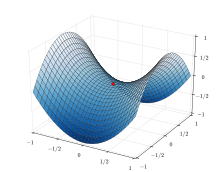Minimax theorem
In the mathematical area of game theory, a minimax theorem is a theorem providing conditions that guarantee that the max–min inequality is also an equality. The first theorem in this sense is von Neumann's minimax theorem about zero-sum games published in 1928,[1] which was considered the starting point of game theory. Von Neumann is quoted as saying "As far as I can see, there could be no theory of games ... without that theorem ... I thought there was nothing worth publishing until the Minimax Theorem was proved".[2]
Since then, several generalizations and alternative versions of von Neumann's original theorem have appeared in the literature.[3][4]

Formally, von Neumann's minimax theorem states:
Let and be compact convex sets. If is a continuous function that is concave-convex, i.e.
Then we have that
Special case: Bilinear function[edit]
The theorem holds in particular if is a linear function in both of its arguments (and therefore is bilinear) since a linear function is both concave and convex. Thus, if for a finite matrix , we have:
The bilinear special case is particularly important for zero-sum games, when the strategy set of each player consists of lotteries over actions (mixed strategies), and payoffs are induced by expected value. In the above formulation, is the payoff matrix.
See also[edit]
- Sion's minimax theorem
- Parthasarathy's theorem — a generalization of Von Neumann's minimax theorem
- Dual linear program can be used to prove the minimax theorem for zero-sum games.
- Yao's minimax principle
References[edit]
- ^ Von Neumann, J. (1928). "Zur Theorie der Gesellschaftsspiele". Math. Ann. 100: 295–320. doi:10.1007/BF01448847. S2CID 122961988.
- ^ John L Casti (1996). Five golden rules: great theories of 20th-century mathematics – and why they matter. New York: Wiley-Interscience. p. 19. ISBN 978-0-471-00261-1.
- ^ Du, Ding-Zhu; Pardalos, Panos M., eds. (1995). Minimax and Applications. Boston, MA: Springer US. ISBN 9781461335573.
- ^ Brandt, Felix; Brill, Markus; Suksompong, Warut (2016). "An ordinal minimax theorem". Games and Economic Behavior. 95: 107–112. arXiv:1412.4198. doi:10.1016/j.geb.2015.12.010. S2CID 360407.













